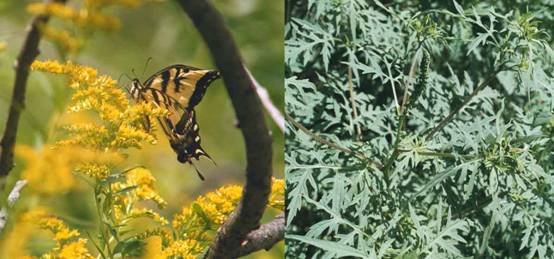

PHOTO COURTESY OF GARRY KESSLER
Left, at the Bowman Street Conservation Area, goldenrod attracts insects, such as this tiger swallowtail butterfly, to carry its heavy pollen from flower to flower. Right, by the side of Ruggles Street, light pollen from this ragweed plant will fly on the wind, finding its way to other ragweeds and human noses.
August 20, 2004, Page 5
NATURE NOTES
By ANNIE REID
Westborough Community Land Trust
Late-summer sneezing
Goldenrod is blooming in Westborough--it's time for kids to get ready for school and for many of us to start sneezing. Is goldenrod to blame for hay fever, as so many people think?
Most of us know that pollen causes hay fever if you happen to be sensitive to it. But is the offending pollen from goldenrod? Contrary to popular opinion, the many kinds of goldenrod (Solidago species) in Westborough are not the source of the trouble. Instead, the culprit is common ragweed (Ambrosia artemisiifolia), which blooms at the same time of year.
The best clue to the culprit lies in the attractive showiness of goldenrod flowers as opposed to the barely noticeable green ragweed flowers. There's a reason behind this big difference in the way the flowers look.
Most goldenrods have large, bright yellow flowerheads--with many tiny flowers arranged in graceful plumes, wands, clubs, or flat-topped clusters--because they are pollinated by insects. The showy flowers attract the bees and butterflies that carry their pollen.
Accordingly, goldenrod pollen grains are relatively large and heavy. This type of pollen sticks to visiting insects and travels with them to other flowers for pollination. It doesn't drift to our noses.
Ragweed, on the other hand, doesn't need colorful blossoms or insects because it is wind-pollinated. Its flowers are green and inconspicuous among its fern-like leaves.
Not surprisingly, ragweed pollen grains are small and light, easily blown about by the wind. They come in vast numbers, contaminating the air for hay fever sufferers.
By the same logic of nature, most garden flowers with attractive blossoms are insect-pollinated and do not cause hay fever. But many trees and grasses--with inconspicuous blossoms in the spring--are wind-pollinated and cause misery for people who are bothered by their particular pollens.
Ragweed is a major cause of hay fever. It affects about 75 percent of the people who are allergic to pollen. If you are one of these people, you can do yourself a favor by removing nearby ragweed plants. It makes sense to pull up and get rid of any common ragweed that you might find growing around your yard, driveway, and general vicinity. Ragweed pollen does travel on the wind, but most of it goes no more than a few hundred yards from the plant that produced it.
As for goldenrod, if you have ever walked through a field of it or picked it for a late summer bouquet, you've probably discovered that it can harbor quite a collection of insects. Its flowers produce a rich supply of nectar that attracts them, especially when other flowers disappear as fall approaches.
Customers include bumblebees and honeybees, as well as various flies that resemble them, complete with yellow and black stripes. Butterflies, ants, and wasps also frequent goldenrod.
With all this insect traffic, goldenrod is a good place for predatory insects to hunt other insects. Some of the hunters include yellow jackets and the yellow goldenrod spider (Misumena vatia). This spider is yellow like the goldenrod flowers it hides in. Instead of spinning a web to catch prey, it lies in wait, camouflaged. Then it grabs and paralyzes a visiting insect, such as a bumblebee. Goldenrod may also harbor a type of praying mantis, which also eats other insects.
Our goldenrods and common ragweed are native plants. In the past, goldenrods have been a source of yellow dye and ragweed has yielded a green dye. Historically, both goldenrods and ragweed have served as medicinal herbs for various ailments.